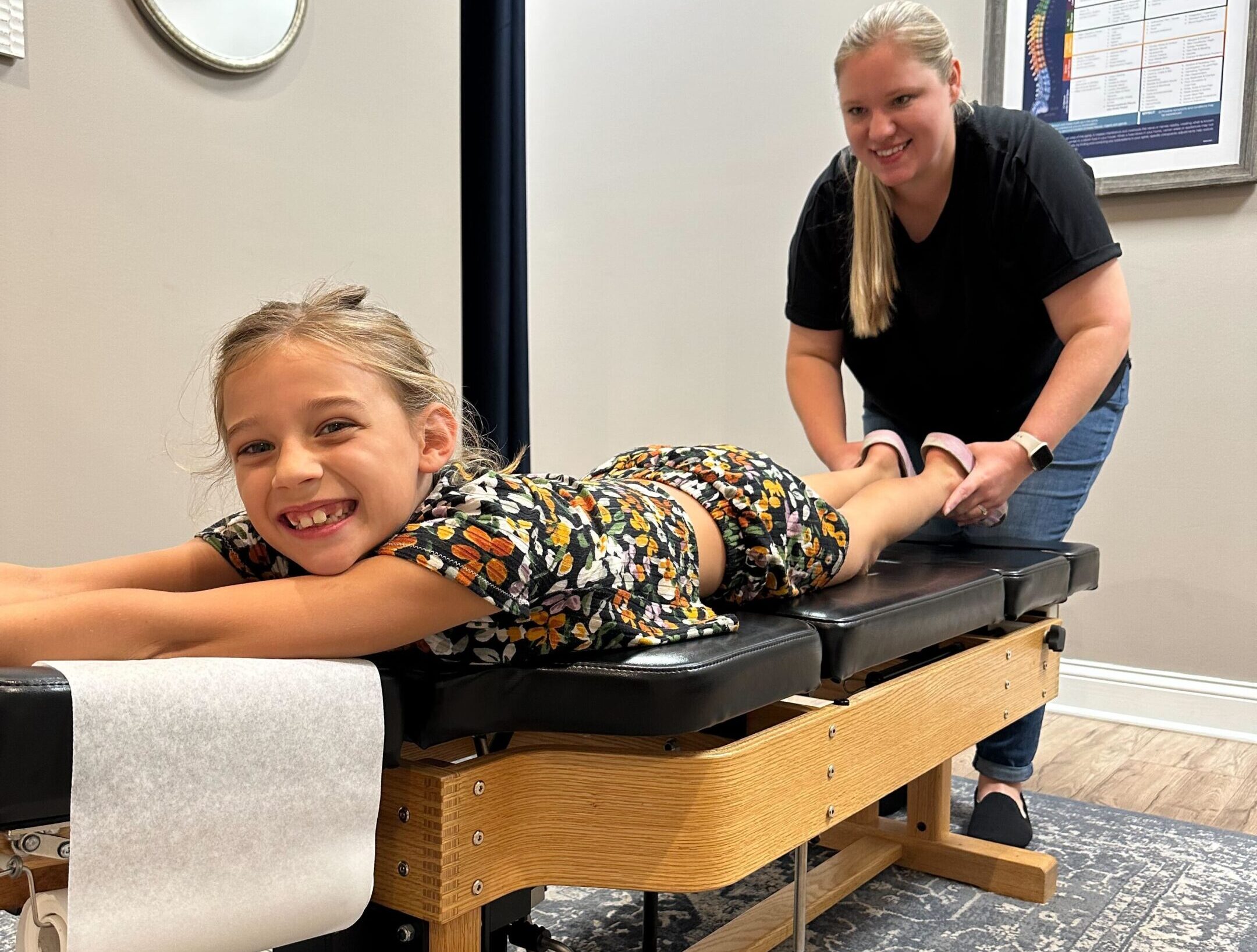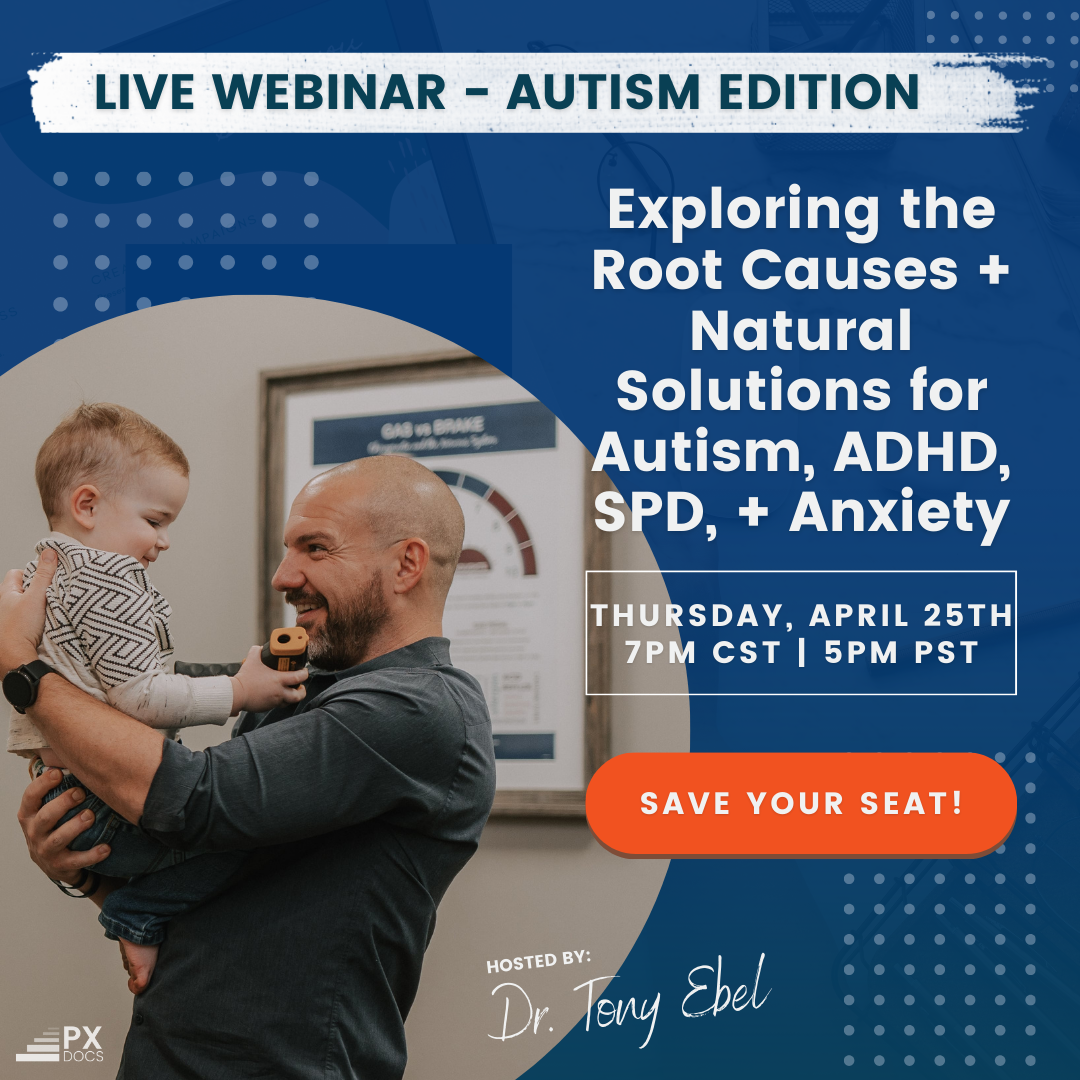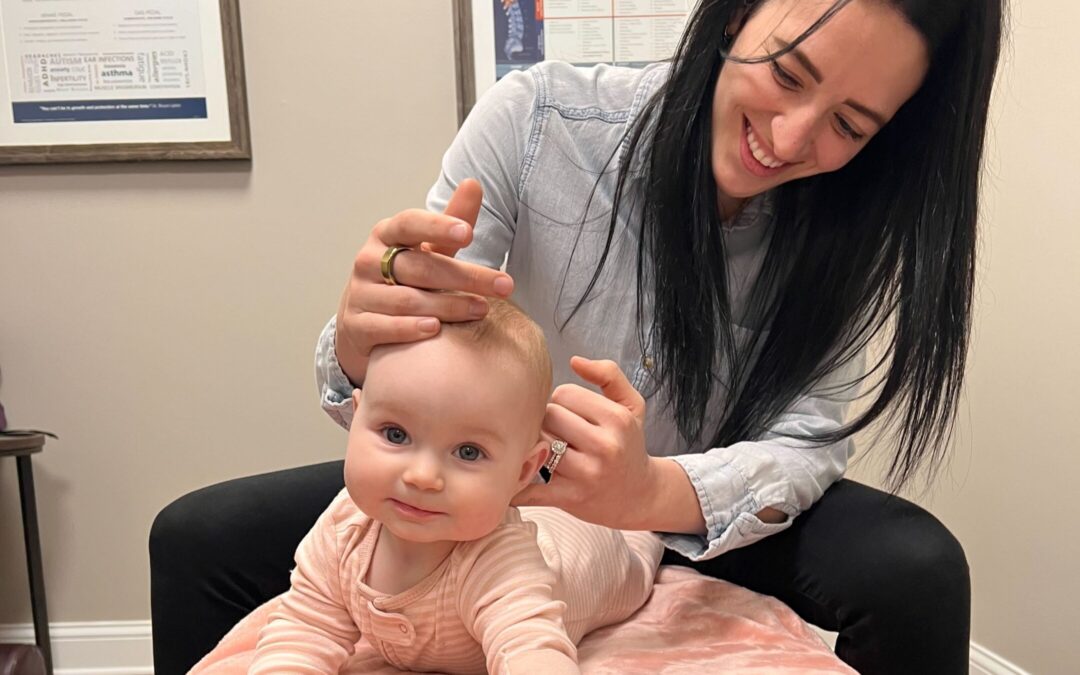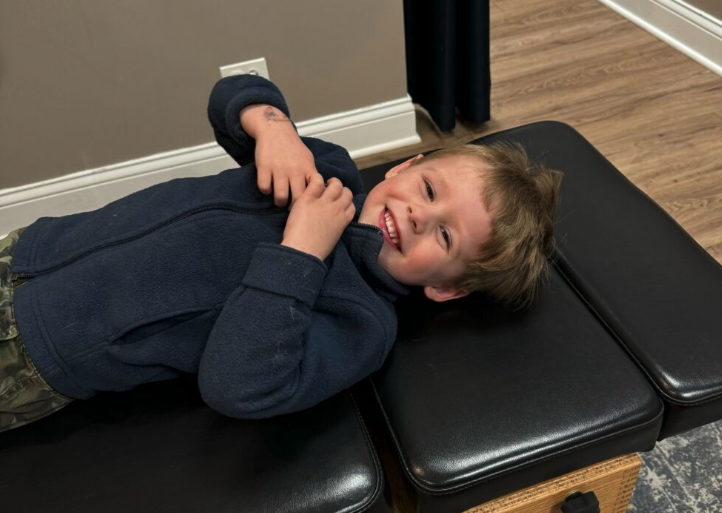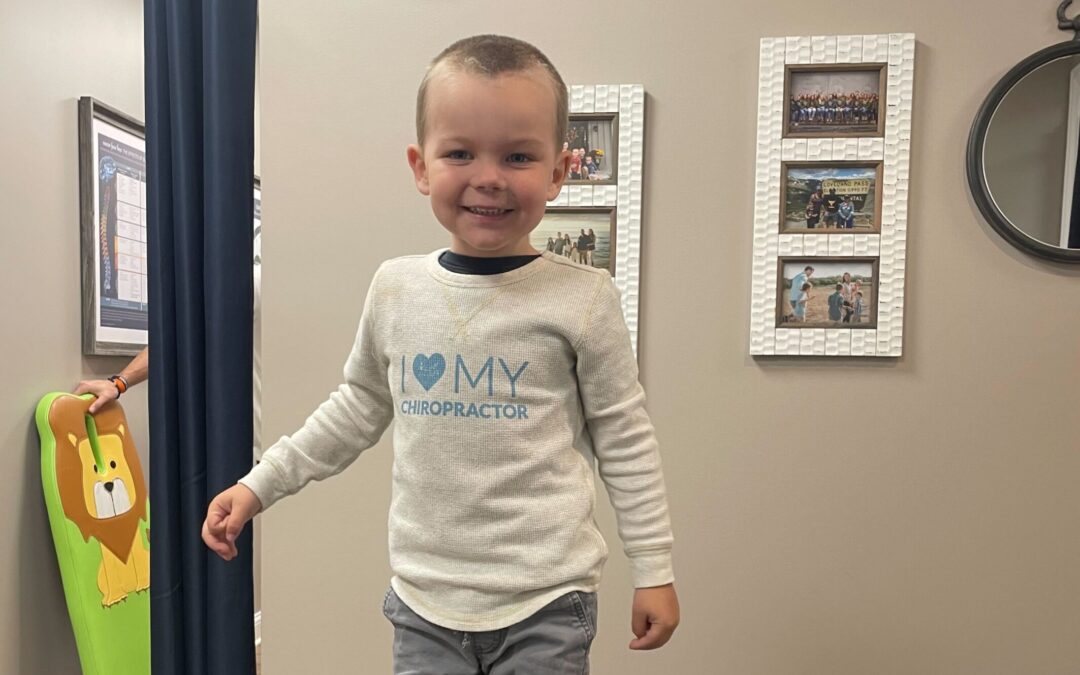Attention Deficit/Hyperactivity Disorder (ADHD) diagnosis rates have reached unprecedented levels, with more children getting diagnosed every year. Nearly 10% of all school-aged children in the U.S. live under the label’s restrictions.
Yet for kids struggling with impulsiveness, emotional dysregulation, disorganization, and hyperactivity, lasting relief from behavioral programs, elimination diets, supplements, and medication remains elusive for most families. If you feel your bright, creative child’s challenges result from something deeper, you may be on to something – an overlooked root cause called vagus nerve dysfunction.
The vagus nerve and ADHD play an interconnected role, as the vagus nerve is the critical messenger carrying signals between the brain and organs, regulating heart rate, breathing, digestion, inflammation, and the entire parasympathetic relaxation system. When this neurological superhighway develops impairment from early trauma, chronic stress, or nervous system dysfunction, children manifest all the classic ADHD symptoms.
Emerging research now clearly traces poor attention, emotional reactivity, fidgeting, digestive issues, and sleep disorders back to impaired vagal capacity and neurological miscommunication. By addressing the underlying vagus nerve dysfunction and nervous system imbalance through specialized testing and protocols, children can often overcome ADHD’s trademark challenges without reliance on drugs and medication long-term.
Do you have a bright, creative child who struggles to focus or sit still? Maybe they fidget constantly or have frequent emotional meltdowns? As a parent, your heart breaks when you see them struggling in school or unable to make friends. You’ve likely tried various behavioral programs, elimination diets, supplements, and maybe even stimulant medications, hoping something works. But if lasting relief remains elusive, an overlooked root cause might be to blame—an impaired vagus nerve.
What is the Vagus Nerve?
The vagus nerve is the longest and most complex cranial nerve, starting at the brainstem and traveling down to the various organs and glands within the abdomen, hence its nickname as the “wandering nerve.” As the main component of the parasympathetic nervous system, the vagus nerve activates the “rest, digest, and regulation” response to slow heart rate, activate digestion, regulate breathing rate, modulate inflammation, and promote healing once threats pass. The vagus nerve is also heavily involved in speech, socialization, and emotional regulation.
Over 75% of all nerve fibers carrying sensory signals about organ function travel along vagal pathways. This makes the vagus nerve disproportionately influential in coordinating multiple body processes critical for health and overall well-being. When not functioning properly, symptoms like insomnia, headache, fatigue, anxiety, gut issues, and poor focus occur.
Why Does the Vagus Nerve Matter for ADHD?
Research clearly demonstrates links between impaired vagal tone, communication issues between the brain and body (dysautonomia), and Attention Deficit/Hyperactivity Disorder (ADHD).
Kids struggling with ADHD frequently have low heart rate variability measurements, indicating reduced vagus nerve activity and parasympathetic tone. This fuels continual sympathetic “fight-or-flight” overdrive, contributing greatly to distraction, hyperactivity, impulsivity, and emotional dysregulation. ADHD medications only temporarily increase neurotransmitters without addressing the root cause.
Optimizing vagus nerve function and restoring appropriate nervous system communication supports lasting improvement in symptoms by activating the body’s natural relaxation pathways.
The Vagus Nerve-ADHD Connection
The vagus nerve is the critical messenger carrying signals between the brain and organs that regulate heart rate, breathing, digestion, inflammation levels, sensory processing, and the entire parasympathetic relaxation system. When this vagal superhighway develops dysfunction from early trauma, chronic stress, or poor nervous system communication, children display all the hallmarks of ADHD. Research now clearly ties vagus impairment to attention/focus challenges, hyperactivity, sleep and digestive disorders, emotional dysregulation, and more.
If you have exhausted typical treatment options without results or want to avoid medication side effects altogether, specialized testing and natural support and stimulation for the vagus nerve provide new hope for families who want to put drugs and medication as a last resort. In this article, we examine how vagus health impacts ADHD, identify signs of nerve dysfunction, and outline new care options to address the root cause by optimizing nervous system balance naturally. You and your child deserve care options that address root causes head-on, not just ones that look to treat and suppress symptoms. Read on to discover more about how this process works.
What Causes Vagus Nerve Dysfunction?
The intricate neuromuscular tissues and pathways surrounding the vagus nerve are extremely sensitive to both physical tension and inflammation. Physical trauma during birth, infections like PANDAS or COVID-19, poor diet, and toxin exposure all cause what we call subluxation along vagus nerve pathways, leading to impaired signaling capacity and overall neurological imbalance
Common birth interventions, including vacuum/forceps extraction and C-sections, place enormous physical strain on the vagus nerve and surrounding tissues. Spinal tension, misalignments, and subluxation frequently occur in this delicate brainstem and upper neck region, interfering with communication between the brain, vagus nerve, and the rest of the body. This leads to alterations in gross motor development, sensory modulation, and overall development and can also fuel chronic gut issues, food sensitivities, sickness, and heightened inflammation – all disturbing vagal tone further as these conditions persist and become repetitive.
As children grow, regular childhood injuries, poor posture from devices, and dental or cranial restrictions can also place stress on the vagus nerve. Medications like antibiotics can also alter and inhibit key nerve signaling capacity over time by disrupting the microbiome and gut-brain connection.
Gradually, the “rest and digest” system stays suppressed and underactive. Symptoms like headache, anxiety, poor stamina, intestinal discomfort, sleeplessness, and heart palpitations increase. Attention span, impulse control, and emotional regulation falter – the hallmark struggles of ADHD.
The good news is that as Neurologically-Focused Chiropractors, we can directly measure subluxation patterns, neurological dysfunction, and dysautonomia using an incredible piece of technology called INSiGHT Scans. Out of all the scans, the HRV (Heart Rate Variability) is the most direct and effective measurement of the vagus nerve and can find and measure vagus nerve dysfunction directly, therefore making it a wildly important and effective tool in caring for ADHD naturally.
The Vagus Nerve-ADHD Connection Explained
The Science Between Vagus Nerve Dysfunction and ADHD
Emerging research clearly demonstrates links between impaired vagal tone, poor nervous system communication (dysautonomia), and Attention Deficit/Hyperactivity Disorder (ADHD), one of the most rapidly growing childhood neurological disorders today.
Multiple studies observe children struggling with ADHD frequently have low heart rate variability measurements, indicating reduced vagus nerve activity and parasympathetic tone. This fuels sympathetic “fight-or-flight” overdrive linked to poor executive functioning skills like emotional regulation, working memory, organization, prioritizing, and impulse control. ADHD medications provide symptomatic relief by increasing critical neurotransmitters like dopamine. However, prescription stimulants and other pharmacological approaches do not address the underlying neurological imbalance, leading to the challenges in the first place.
Alongside attention disorders, kids with vagus nerve dysfunction frequently display related digestive complaints like abdominal discomfort, acid reflux, bloating, diarrhea, and constipation. Direct connections between the enteric nervous system lining the gut and central brain explain the intestinal issues and food sensitivities so often seen with ADHD. Sleep disorders, growth delays, migraine, and more also commonly arise as well.
Treating just surface symptoms without addressing nervous system dysfunction fails to provide lasting relief off the ADHD spectrum for most children. Recent trials utilizing direct vagus nerve stimulation observe notable reductions in ADHD severity by re-balancing autonomic nervous system activity. But non-invasive techniques like chiropractic adjustments to release built-up stress and subluxation and metrics quantifying HRV to track progress help reboot and strengthen the nervous system and vagus nerve function.
As care continues, the body regains the ability to produce a parasympathetic and vagus nerve response at appropriate times when relaxation and regulation are most needed. When subluxation and dysautonomia are addressed in full with a neurological restoration care plan like that provided by those providers in the PX Docs Network, many children see their ADHD go from a daily struggle and obstacle to well-being to a superpower and distinct advantage to getting the most out of life!
ADHD and sensory children under regular Neurologically-Focused Chiropractic Care are often the most empathetic, energetic, and creative kids out there, who still maintain the ability to regulate their emotions and keep their impulsivity in check when called for.
Signs Our Child’s Nerve Dysfunction Could Be Impacting ADHD
Since the vagus nerve regulates so many crucial bodily processes, signs of impairment can be complex and varied. However, several key indicators provide clues that reduced vagus nerve dysfunction is playing a role in health or developmental issues:
- Low Heart Rate Variability (HRV): Shifting states with ease calms ADHD
- Gastrointestinal Problems: Leaky gut & inflammation disturb signaling
- Frequent Infections: Nerve coordinates immune response
- Poor Stress Tolerance: Transitions and changes difficult
- Sleep Challenges: Calming input like weighted blankets needed to rest
- Focus & Sensory Issues: Require extra stimuli to concentrate
- Growing Pains: Subluxation creates referred neuromuscular pain and tension
If your child displays clusters of such symptoms, specialized testing and care for optimizing vagus nerve activity may provide answers where medication has reached its limits.
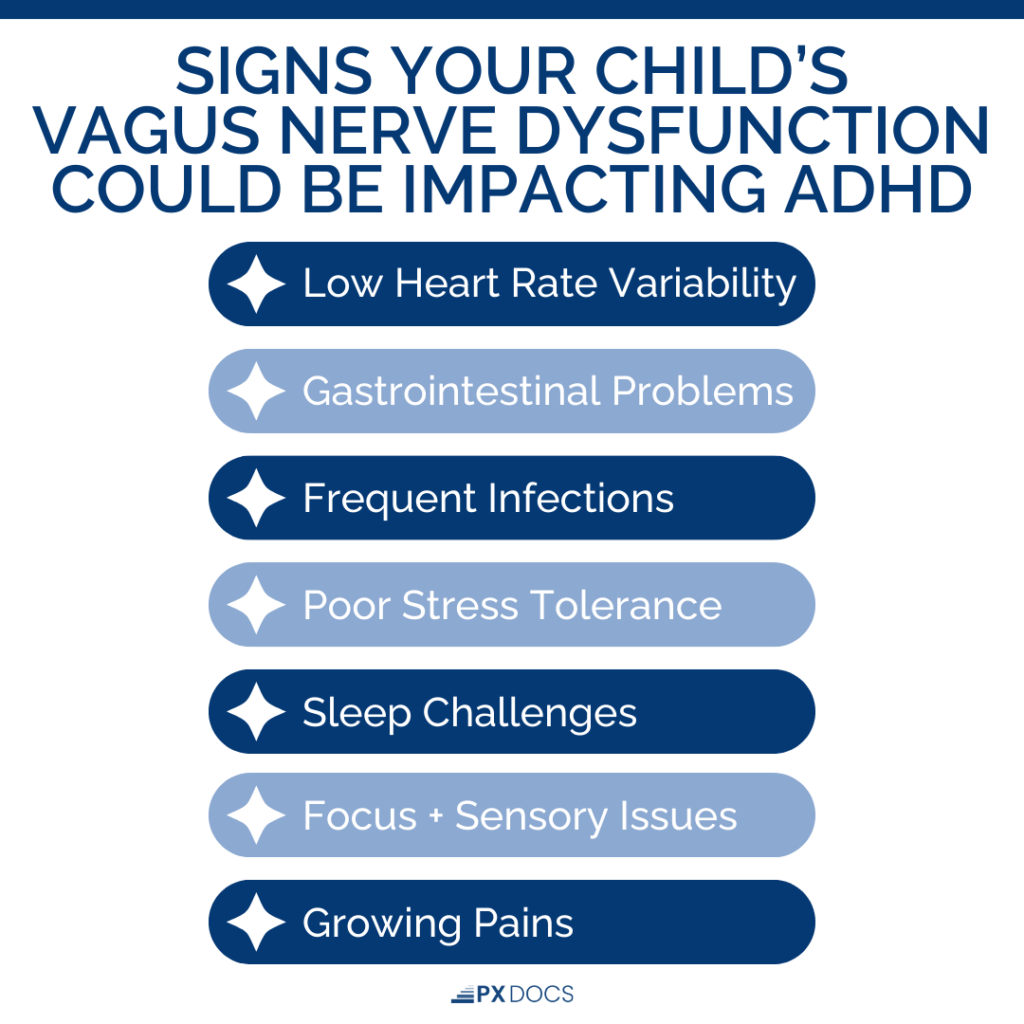
The PX Doc Plan to Test and Care For Vagus Nerve Dysfunction
Our PX Docs network provides tailored protocols unique to each individual’s needs and works to stimulate and strengthen your child’s vagus nerve, restoring nervous system balance gently.
The first step involves gathering a detailed and personalized case history for each child. We then determine the current function of the vagus nerve and autonomic nervous system via INSiGHT Scans, which enable the direct measurement of a child’s subluxation patterns and dysautonomia. This step is considered essential because it allows the identification and tracking of the foundational root causes.
Customized care plans then utilize precise neurologically-focused adjustments to address subluxation, release stuck fight or flight tension, activate the vagus nerve, and improve communication between the brain and the rest of the body. The first response most children have to this specialized form of chiropractic adjustments is better sleep, more calm, and improved sensory regulation.
If you’re ready to address the root cause of your child’s neurological challenges head-on, then check out our directory and reach out to your local PX Doctor right away. Safer, more natural options exist that address vagus nerve dysfunction and improve neurological communication and overall function. Help your child find balance and reach their highest potential—you’ll never stop believing in them, and neither will we!

